About Mizoram - > Dances
Mizo people have a number of dances which are accompanied with
few musical instrument like the gong and drum
Khuallam:
Khuallam literary means 'Dance of the Guests'. It is a dance
usually performed in the ceremony called 'Khuangchawi'. In order
to claim a distinguished place in the society and to have a
place in paradise or Pialral one has to attain the coveted title
of 'Thangchhuah'. There are two ways of attaining this title.
(Video Clip)
| Firstly one
could attain the title Thangchhuah by proving one's mettle
in war or in hunting by killing many animals which should
include animals like barking,deer, wild boar, bear, wild gayal, viper, hawk etc.Secondly one could also get the title
of Thangchhuah by performing feats and dances. Thangchhuah
therefore could be attained only by the brave or by the
rich. The ceremonies performed in the second method are known as Khuangchawi. |
|
 |
Guests invited from the other villages at the Khuangchawi ceremony enter the arena dancing Khuallam.
Traditional hand woven Mizo cloth known as Puandum is wrapped
over the shoulders and the dance is performed by swaying the
cloth. Puandum has the colors black, red, yellow and green
stripes. Significantly Puandum is an indispensable item which
every girl has to take along with when she gets married. It is
used when her husband dies to cover the dead body. As most other
folk dances of the Mizos, this dance is accompanied by a set of
gongs known as Darbu and no song is sung. It is generally
performed in large numbers.
| Cheraw: Cheraw is a very old
traditional dance of the Mizos. It is believed that the
dance had already existed way back in the 1st Century A.D.,
while the Mizos were still somewhere in the Yunan Province
of China, before their migration into the Chin Hills in the
13th Century A.D., and eventually to the present Mizoram.
Some of the tribes living in South East Asia have similar
dances in one form or the other with different names. |
|
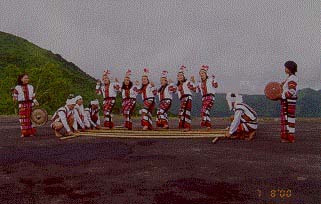 |
| Men sitting face
to face on the ground tap long pairs of horizontal and cross
bamboo staves open and close in rhythmic beats. Girls in
colorful Mizo costumes of 'Puanchei', 'Kawrchei'. Vakiria'
and 'Thihna' dance in and out between the beats of bamboo.
This dance is now performed in almost all festive occasions.
The unique style of the 'Cheraw' is a great fascination
everywhere it is performed. Gongs and drums are used to
accompany the dance. Today modern music also complements the
dance. (Video Clip) Sarlamkai/Solakia :
This is an impressive dance originating from the Pawi and
Mara communities in the southern part of Mizoram. This dance
is known as 'Sarlamkai' whereas the Lushais referred to it
as 'Rallu Lam'. In older days when the different tribes were
constantly at war with each other, a ceremony to deride the
vanquished beheaded skull of the enemy was usually held by
the victor. This ceremony is performed to ensure that the
vanquished soul remains a slave to the victor even when the
latter also dies. |
| The derision ceremony usually
lasts for 5(five) days. The first 2 (two) days is spent in
merry-making, singing alongside drinks and a non-vegetarian
feast. On the third day a pig is slaughtered and he victor
paints his whole body with the animal's blood, which he only
washes off on the evening of the fourth day or on the
morning of the fifth day. During this 5(five) days period,
the victor is not to sleep with any women. life. |
|
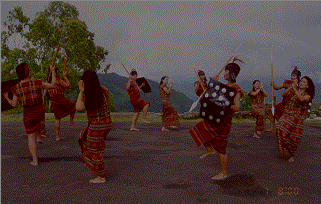 |
| If he does so, the
vanquished soul is believed to be infuriated and cause upon
the victor, a permanent disability inAny person who brings
about an occasion for such a ceremony is highly regarded and
respected by the people, the king as well as his
elders.Therefore, every adult strives with all his or her
capability to be such a hero. The courage and bravery of
such heroes is a great consolation for the people when faced
with any external aggression. It is during this ceremony
that the 'Sarlamkai' dance is performed. As is obvious, it
is a warrior dance performed to celebrate a victory in war.
Songs are not sung; only gongs or cymbals or drums are used
for making beats. In the dance, boys and girls standing in
alternate position, dance in circles. They generally wear
colorful dresses while the leader is dressed as a warrior.
Chailam: Chailam is a popular dance
performed on the occasion of 'Chapchar Kut' one of the most
important festivals of the Mizos. In this dance, men and
women stand alternatively in circles, with the women holding
on to the waist of the man, and the man on the women's
shoulder. In the middle of the circle are the musicians who
play the drums and the mithun's horn. |
| The musician playing the drum
choreographs the entire nuances of the dance while the one
with the mithun's horn chants the lyrics of the 'chai' song.
For the dance to start, the drummer beats on the drum, and
upon the fourth stroke of the drum the chai song is sung
with the rhythmic swaying of the dancers to the left and
right, in accordance with beats of the drum. |
|
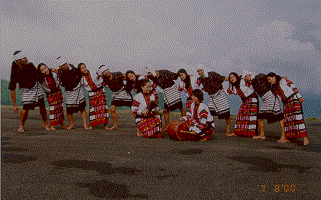 |
| Depending on the
nuances followed, the chailam' has four versions, viz 'Chai
Lamthai I, 'Chai Lamthai II, Chai Lamthai III and 'Chai
Lamthai IV'. Legend has it that once a king and his men went
out for hunting. Unfortunately, they failed miserably and
had to be contended without a kill. The king, then seeing
the utter disappointment of his men, rose to the occasion
and consoles them by inviting them for a drink of rice beer
at his palace. On being intoxicated by the drinks, the party
then culminated by singing and dancing followed by a
sumptuous feast. Since then, every year, the community
continues to enliven the memory of this occasion be
celebrating it with various entertainment programs, thus
giving rise to one of the most important festivals of the
Mizos, the 'Chapchar Kut'. In this dance, musical instrument
like drum and horns of mithun are used for making beats. The
festivals continues for a week or more. In olden days, the 'Chai'
dancers used to drink rice beer continuously during singing
and dancing.
Chawnglaizawn : This is a
popular fold dance of one of the Mizo communities known as
Pawi. This dance is performed in two different occasions. |
(i) It is performed by a
husband to mourn the death of his wife. The husband would be
continuously performing this dance till he gets tired.
Friends and relatives would relieve him and dance on his
behalf. This signifies that they mourn with the bereaved.
(ii) Chawnglaizawn' is performed on festivals and also to
celebrate trophies brought home by successful hunters. |
|
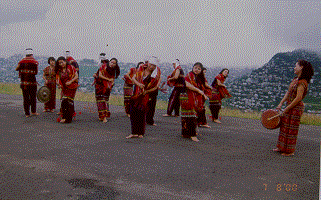 |
| On such occasions,
it is performed in groups of large numbers. Boys and girls
standing in rows dance to the beat of drums. Shawls are used
to help the movement of the arms, which also adds color to
the dance. Only drums are used in this dance.
Chheihlam : Chheihlam' originated
after the year 1900 on the lines of the songs known as 'Puma
Zai' and the dance known as 'Tlanglam'. It is a dance that
embodies the spirit of joy and exhilaration. It is performed
to the accompaniment of a song called 'Chheih hla'. People
squat around in a circle on the floor, sing to the beat of a
drum or bamboo tube while a pair of dancers stand in the
middle, recite the song and dance along with the music. |
| It was a dance performed over a
round of rice beer in the cool of the evening. The lyrics
are impromptu and spontaneous on the spot compositions
recounting their heroic deeds and escapades and they also
praise the honored guests present in their midst. While
singing the song accompanied by sound produced by beating of
the drum or clapping of hands, an expert dancer performs his
dance chanting verses with various movements of the body,
with limbs |
|
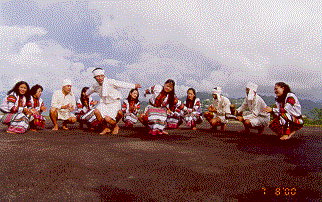 |
| close to the body
and crouching low to the ground. As the tempo rose and the
excitement increases, people squatting on the floor leave
their seats and join him. Guests present are also invited to
join the dance. Today 'Chheihlam' is performed on any
occasion with colorful costumes, normally in the evening
when the day's work is over |
| Tlanglam:
Tlanglam is performed throughout the length and breadth of
the State. Using music of Puma Zai, there have been several
variations of the dance. This dance is one of the most
popular dances these days by our cultural troupes in various
places. Both sexes take part in this dance. |
|
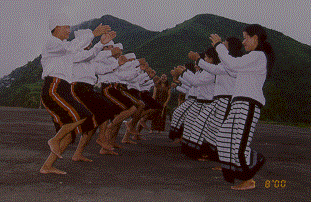 |
|
Zangtalam: Zangtalam is a popular
Paihte dance performed by men and women. While dancing, the
dancers sing responsive song. A drummer is a leader and
director of the dance. The duration of the dance depends on
the drummer. |
|


